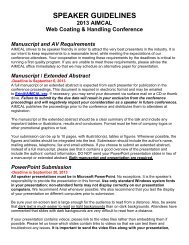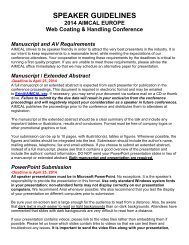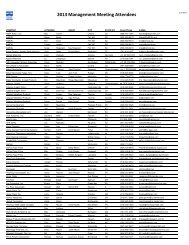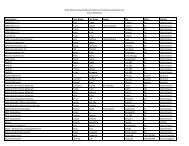Coating - Aimcal
Coating - Aimcal
Coating - Aimcal
You also want an ePaper? Increase the reach of your titles
YUMPU automatically turns print PDFs into web optimized ePapers that Google loves.
Executive Summaries • A Look Ahead<br />
Labels & Labelstocks<br />
There’s no doubt about it. The label industry has changed<br />
dramatically in recent years. It’s now totally global –<br />
whether industry suppliers or label-user brand owners<br />
– they have a presence almost everywhere. Even key<br />
converters are becoming increasingly international in<br />
their operations with sites in more than one country or<br />
continent.<br />
The challenge for the industry has been that 80 percent<br />
of label growth now comes from emerging markets,<br />
especially China, India, South America, Eastern Europe<br />
and Southeast Asia. Globally, labelstock growth still runs<br />
at around 4-6 percent per annum; it’s just in different<br />
places than where it historically used to be. While north<br />
America and European market growth has declined to a<br />
miniscule amount each year, places like China and India<br />
are seeing double-digit growth. Suppliers to the industry<br />
have had to rapidly adapt to this pattern of change,<br />
building new coating, manufacturing and distribution/<br />
service centers in developing markets.<br />
Demand for label materials worldwide — now around 44<br />
billion sq meters each year — has in turn lead to quite<br />
rapid materials inflation and significant cost increases for<br />
paper, film, adhesives and chemicals. This all comes at a<br />
time when major buyers of labels have been rationalizing<br />
their product lines and, at the same time, changing their<br />
buying patterns to shorter and shorter run lengths, more<br />
just-in-time sourcing and more variations and versions. In<br />
addition, they have been looking to drive down prices.<br />
not unsurprisingly, label-press manufacturers and<br />
converters have had to adapt to the changing market<br />
requirements for shorter runs and faster job changeover.<br />
A key beneficiary has been the digital label press. Well<br />
over 1,500 digital presses have been installed in the<br />
global roll-label industry in the past eight years alone.<br />
More than 300 new installations are expected during<br />
2012, which will represent around 20 percent of new<br />
narrow-web press installations this year.<br />
Conventional label-press manufacturers are not sitting<br />
idly by while digital races ahead. They have been bringing<br />
out new innovations to compete in the quick-change,<br />
quick-response, short-run marketplace. nilpeter, for<br />
example, recently introduced its Revolver Die System<br />
that enables a new die to be prepared while the press<br />
is running. Shorter web paths, new chambered doctorblade<br />
systems, slide-out print units, etc., are all helping<br />
conventional (flexographic) press manufacturers to<br />
compete in the new world of digital. Combination<br />
printing-process presses are also continuing to find new<br />
applications and markets.<br />
96 | 2012 AIMCAL SourceBook<br />
With shorter runs and more job changeovers comes a<br />
growing need for enhanced prepress solutions, such as<br />
HD Flexo and Digital Flexo Suite from EskoArtwork, and<br />
more comprehensive management information systems<br />
(MIS) and workflow software to handle 15, 20 or more job<br />
changes per press per day.<br />
On top of all the market and technology trends, there’s<br />
also been an increasing demand from brand owners<br />
and consumers for the label industry to be “greener.”<br />
Labelexpo Europe saw the launch of thinner materials<br />
(15 micron), fully-recyclable film liner, more labels per<br />
roll, new recycling initiatives and new developments in<br />
linerless and wash-off labels. Ink manufacturers, press<br />
manufacturers, UV-curing system suppliers and others<br />
are all applying environmental, waste-handling and<br />
sustainability solutions.<br />
So where does the label industry stand today? Pressuresensitive<br />
labels continue to grow and are the dominant<br />
technology in developed markets. Wet-glue labels are<br />
still strong in emerging markets, but face increasing<br />
competition. Shrink-sleeve labeling also is quite strong in<br />
emerging markets and is even finding new applications<br />
and markets in developed countries, but from a smaller<br />
market base.<br />
new ideas, applications and markets continue to be found<br />
for labels. QR codes, Snap Tags, electronic labels and<br />
other innovative, interactive ideas are gaining ground.<br />
Smart labels are finding increasing applications, while<br />
anti-counterfeit and brand-protection solutions are on<br />
the rise. Converters certainly need to become more<br />
customer- and service-focused, developing Web-toprint<br />
portals, introducing MIS systems to link printer and<br />
customer, and even becoming one-stop shops for more<br />
than one label technology or to additionally supply folding<br />
cartons, flexible packaging, pouches, sachets, etc., to the<br />
same customer.<br />
The world of labels is continuing to change, perhaps<br />
faster now than ever before, but the opportunities are<br />
still out there, and the best converters will survive and<br />
grow. Labelexpo Americas in Chicago (Sept. 11-13)<br />
undoubtedly will have much to encourage that growth. n<br />
By Mike Fairley, director-strategic development,<br />
Labels and Packaging Group, tarsus, +44-20-8846-<br />
2700, email: mfairley@labelling.fsnet.co.uk,<br />
www.labelexpo.com











